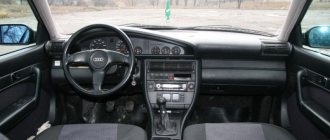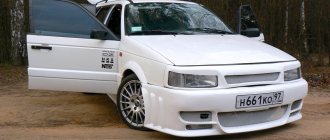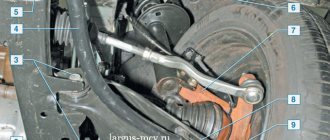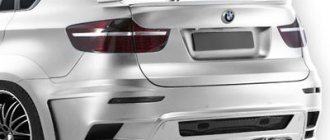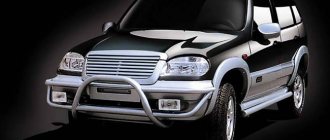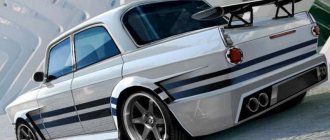Audi 80 is a famous line of cars that were produced in sedan and station wagon body styles. They are still very popular, despite the fact that the last example of this model range rolled off the assembly line in 1996 after 30 years of continuous production.
They have a strong galvanized body and a beautiful appearance, but some parts of the interior and exterior are already outdated and require improvement. Therefore, for Audi 80 owners, tuning is a real way to improve the appearance or individual characteristics of their favorite car.
Content
1. Where to start tuning an Audi 80 2. How to increase power with tuning 3. Tuning the grille on a car 4. How to improve sound insulation 5. Tuning services 6. How to carry out economical tuning
If you are the owner of an Audi 80 car and are thinking about how to increase the car’s performance and save on car repairs and maintenance, then you need to familiarize yourself with information about how Audi 80 tuning is carried out and what basic capabilities it provides. It should be immediately noted that if you have the appropriate skills, you can carry out tuning work yourself, and if necessary, seek qualified support from service technicians.
To perform some tuning work, special complex equipment and special devices are required; this should be taken into account when planning tuning work.
How to tune the grille if the factory one has completely deteriorated
1. Cut out the entire inner part of the old grille, leaving only the frame. You need to cut with a hacksaw blade for metal. 2. Put a special attachment on the drill and remove any imperfections. The paint also needs to be removed down to the plastic. 3. Add a tuning grid, degreasing wipes, putty and black paint for plastic.
4. Degrease the frame and putty to level the entire surface. 5. After the putty dries, the frame needs to be sanded. 6. In the upper part of the frame, we make cuts on the remnants of the ribs that the middle part was holding on to. We will insert a new grid into these cuts. 7. Paint the frame. We apply two or three layers of paint. 8. We adjust the grille to the size of the frame. 9. We put it in the cuts and fasten it with wire at the bottom. On the sides we simply bend and cut off the excess. The grille for our Audi is ready, let’s put it in place.
Where to start tuning Audi 80
Before tuning the Audi 80, you need to bring the car back to normal condition. To do this, a high-quality visual inspection and regular technical inspection are carried out, aimed at timely identification of faults and planning of vehicle maintenance work. During a visual inspection of the car, you can find that the car's engine is acting up, the suspension requires maintenance and the body needs to be protected from corrosion. All these problems can be solved before tuning the car. It is necessary to correct the main shortcomings, and only then begin tuning the car.
You shouldn’t resort to tuning when the suspension is about to fall apart; extra body kits will only prematurely damage the suspension. In this case, it is necessary to repair the suspension and only then proceed with tuning. By the way, at the stage of repair work, you can choose new wheels and tires for the car, which will significantly extend the service life of the wheelbase.
You can familiarize yourself in advance with video materials and photographs on the topic of tuning the Audi 80.
An unrestrained barrel is an excellent alternative to a fresh domestic sedan. Photo
Review of a car produced in 1989, V 1.8, 90 l. s., carburetor.
I owned an Audi 80 B3 from April 2008 to October 2010. It was my first car. Initially, there was an idea to buy a “nine”, but purely visually looking at the condition of 10-year-old cars of this model, when on one side the cars seem to be nothing, but go around, and there is a wing, as if mice had eaten it, the desire to buy a VAZ disappeared. I've only heard good things about old Audis. I rode a lot as a passenger on a “cigar”. The owner said that these cars are as simple as a bicycle and as durable as horses. “Bochka” is supposedly famous for its weak suspension. Don't know. Mine didn't give me any problems. I changed consumables such as silent blocks and bearings, but nothing more serious failed. I bought the car at the car market, like a woman: blue, pretty. After a couple of months of operation, shoals began to emerge. I won’t go into technical details; I had to invest a lot in the car. I didn’t get any money for current repairs. All spare parts are available, they cost a little more than for the “nine”. There are, however, some expensive parts. For example, my car's vacuum brake booster failed twice. New it costs 7 something for a non-original made to order. The original one is more than 10,000. Such spare parts are always available at disassembly sites, but our prices range from 1800 to 3500. Over the years of owning ancient Germans, I have already gotten the hang of looking for something cheaper. The machine is completely repairable: there are no components that would be inconvenient to get to. Everything is open, everything is comfortable. Body. In my opinion, Audi has the most corrosion-resistant bodies. My car is from 89. only one small saffron was found on the lower left rear door. Now I have a Passat 90 onwards. The body is also strong, that is, the car is not rotten, but periodically you have to give it to a painter to “clean, treat, and touch up.” This was not the case with Audi. Still, these are two cars of different classes. Volkswagen is a people's car with all the attendant comfort. The “barrel” is comfortable for both large and small drivers. I am 160 cm tall, and my husband is 187 cm tall. Comfortable for both thanks to multiple seat adjustments. A huge plus is that there is an elevator. In Volks, again, this is not the case. The previous owner of my current car drove with a pillow under the cover. I adjusted without it. My car was without power steering. Minus for a girl. But the steering wheel is not as heavy as, for example, on the Niva, which I also drive from time to time. The handling is good. The dimensions are small, parking is convenient. The car is maneuverable, but a little dull (it still has a carburetor). I didn’t find data on ground clearance, but I didn’t have any problems with it, in comparison, again, with the same Passat with its ground clearance of 12 cm. Audi bumpers are made of very durable plastic, even on relative off-road conditions, if you shake the bumper on a bump, nothing will happen to him. Fuel consumption. Mine “ate” 10 liters in the city and 8 liters on the highway, did not “eat up” in general. Minus - trunk. He is very small. My ownership of the “barrel” coincided with the active growth of my son. He was then between 3 and 5 years old. This is the age when you need to take a bike with you and a self-propelled car. There are still a bunch of bags to leave when we go out of town. In general, looking at how easily my husband fits all the necessary things into his Volga station wagon and how much space remains, I sighed sadly. When a Passat station wagon turned up for me from a friend, I decided to sell the Audi. Nevertheless, the memories remain the warmest. Nice, simple, unpretentious. She never let me down, only at the very end, before the sale, her Hall sensor was covered, she once stalled in the middle of the road and would not start. We rolled to the side of the road, stood for about 20 minutes, it cooled down a little, started up and made it home. She was selling it and roaring. Honestly. I felt incredibly sorry for the beauty. Still the first car. My soul is attached to her. She was like a member of the family. This is not the case with today's car. In general, I highly recommend the unworn Audi. We need to look for him. For 10 cars, 8 are rubbish. Still, age, Russian roads, crooked “masters” and careless owners are doing their job. But if you come across a worthy copy, you have to take it. IMHO it’s not even correct to compare an old Audi with a fresh VAZ (I mean “whistles” of the ninth, tenth families, four). Thank you for stopping by
Advantages
- comfortable
- body is corrosion resistant
- inexpensive spare parts
- repairable
Flaws
small trunk
Cibulya recommends
How to increase power with tuning
If you have been thinking about how to increase engine power for a long time, then it is worth considering that there are several tuning options that allow you to achieve high results. For example, tuning an Audi 80 and replacing the cylinder block with a more powerful one allows you to increase engine power. For replacement, you can take the cylinder block from a car with higher performance characteristics. You can get a cylinder block from a Golf 2 9A, although they are harder to find than cylinder blocks from other cars.
If your plans include a serious increase in engine power, you can also convert a carburetor engine into an injection engine. Despite the complexity of such work, the result will exceed expectations. To carry out high-quality tuning yourself, you will need a special lift, photos and videos
How to increase engine power relatively inexpensively
About the design and operation of the car Where in Audi.
Audi - brand history. Where Audi is assembled 1. Change the cylinder head. Suitable from:
- Golf 2 KR;
- Golf 2 9A;
- Golf 3 ABF.
The last option is preferable, but it is difficult to find. 2. Convert the carburetor engine to an injection engine, and let the ECU be “January”. All the parts that go to the injector, plus the ECU will cost you approximately 20 thousand rubles. They will take about 30 thousand for the job.
If you wish, you can grind the cylinders so that the total volume becomes 2 liters. After such modifications, you will increase the power (if it was 90 hp) to 150 hp. 3. It is imperative to change the intake and exhaust systems. It’s difficult to advise anything. It’s better to consult with the experts. 4. Since there will be more power, the factory brakes may not be able to cope with it. If you don’t have time and money, you don’t have to think too much. The main thing is to replace the rear brakes with disc ones. It's easy and inexpensive.
Tuning the grille on a car
When you look at the video materials on the topic of tuning the Audi 80, you can note that during the tuning process, car owners also restore the front radiator grille. If you also want to customize the grille, you should cut out the entire inside of the grille and leave only the frame. It is recommended to use a suitable hacksaw. You can remove unevenness after this work by attaching a special attachment to the drill and walking over the unevenness. The paint down to the plastic must also be removed.
Next, tuning the Audi 80 continues with the purchase of a new radiator grille. You will also need to purchase degreasing wipes, black plastic paint and putty. It is necessary to degrease the frame and putty it so that you end up with a smooth surface. After the putty has dried, you need to sand the frame. It usually takes several hours for the putty to dry, depending on the ambient temperature. Then, in the upper part of the frame, on the remnants of the ribs of the middle part, it is necessary to make cuts into which a new grille must be inserted. You can paint the frame with two or three layers of new paint.
The new grille must be adjusted to the size of the frame so that it can be inserted into the cuts and secured with wire. On the sides you can cut off all excess using the same hacksaw for metal. After such manipulations, the grille is ready for full installation in place. As you can see from this material, tuning the Audi 80 is great for transforming the appearance of an old car.
How to improve sound insulation
If while driving your car you hear the body rattling and the engine running, then you should think about replacing the sound insulation. The main materials used to improve the noise insulation characteristics of a car are most often vibration dampers and noise absorbers. Using these tuning materials, you will significantly improve your car and extend its service life. From materials on the topic of tuning, one can judge that you can do anything you want with an old car. You can turn it into a convertible and completely change the doors, you can install new body kits and significantly increase the environmental class of the car.
If you are just planning to tune the Audi 80, start with the following steps:
- find suitable ones
Tuning services
Tuning the Audi 80 provides ample opportunities to improve the performance parameters of the car. You can determine the scope of work and in a short time extend the service life of the main components, achieve higher power from the engine and solve problems, for example, increasing depreciation. It is recommended to start tuning a car with the simplest thing - with external tuning, which is carried out in relation to the headlights and body in order to disguise the new installed equipment on the car.
In addition to replacing the grille on the radiator, you can use such a tuning element as strengthening the suspension. Increased suspension rigidity allows you to extend the service life of shock absorbers and get rid of squeaks and vibrations. These tuning works involve dismantling the rear and front axles and installing new plates, which will significantly improve the car's damping characteristics.
You can tune an Audi 80 without extra costs if you create a retro car based on your car, which will have an attractive appearance and a set of spare parts from other cars, which together will allow you to achieve increased performance. In any case, when planning tuning, you should consider your budget. A full-fledged tuning is sometimes comparable to the price of a major car repair. However, a tuned car has a number of advantages: an increased service life of the main components, an attractive appearance and the ability to save on scheduled repairs and maintenance of the car. For a modern driver, these factors are of significant importance when planning tuning.
How to carry out economical tuning
Economical tuning of the Audi 80 can be done if you use not new parts and consumables, but previously used parts with more advanced performance characteristics. You need to make sure that the new component you are installing on your vehicle is compatible. Often on tuning forums you can read recommendations from car service specialists on the topic of what equipment and spare parts are suitable for tuning work. The information presented will be useful to you if you want to achieve from tuning not only an improvement in the performance parameters of the car, but also the creation of conditions for high-quality and safe driving.
However, tuning the Audi 80 opens up ample opportunities to improve your car. It all depends on what tasks are set for this work, and under what conditions the car will be used in the future. The advantage of high-quality tuning is that the car owner can significantly increase the value of the car and count on a higher selling price for the car in the future. This applies if you are selling a used car through a dealership or through a marketplace. Buyers pay close attention to cars with elements of manual tuning, which significantly increases the car’s attractiveness and allows them to improve operating parameters.
One of the most attractive areas of tuning recently is airbrushing, which involves applying colorful designs to various parts of the body. Airbrushing has several advantages. Firstly, it allows you to protect the car body from corrosion due to high-quality paints and varnishes that are used to apply patterns. Secondly, airbrushing is used to hide minor defects in body finishing; you should not pay special attention to the fact that many car sellers refuse repairs and painting and resort to airbrushing. Tuning the Audi 80 and airbrushing in particular is used to make the appearance of the car more attractive. This is necessary for a car owner who wants to stand out from others with his unusual car.
You can perform airbrushing yourself if you have the appropriate skills or with the support of professionals who will perform all the work efficiently and provide the necessary guarantees. Therefore, if you have an Audi 80 in your garage and you want to transform the appearance of the car and increase its reliability, then use the tuning tips and make your car unique. Today there are hundreds of companies operating in the tuning studio market, but you need to entrust your car to real professionals. Otherwise, the money invested will not pay off, and the result obtained will forever make you doubt the need for tuning. If you were born on the 18th, then my congratulations to you, of course, but the coolest thing is that every month on the 18th on this site you will receive an excellent bonus of 18% https://1win-promokod.com/ you probably don’t even believe your luck, but yes this is so here on the site there are very kind admins who help constantly and give bonuses
High-quality tuning is a wide area that allows you to achieve a variety of goals, ranging from changing the appearance of a car to its complex improvement.
By setting yourself the task of tuning, you will be able to determine the scope of work and plan it in such a way as to achieve a high-quality final result.
And the resulting savings on maintenance and repairs will allow you to use new methods of tuning your car.
Survival test: repair and maintenance of Audi 80 B2
A little bit of history
Before we move on to the Audi 80, let’s go back another ten years before the appearance of this car.
In the early 60s of the last century, entrepreneurs from Audi were puzzled by the idea of firmly gaining a foothold with their car in the golf class. And for this, such a machine had to be made. In order not to spend too much time and money on development (in the golf class, the cost of a future car can be decisive in its fate), we took the already outdated DKW F102 as a basis. This was the last car that would have remained virtually unnoticed if it had not become the basis of the Audi F103. To do this, the car had to be redesigned quite significantly, and most importantly, a new engine had to be installed instead of the outdated two-stroke unit, traditional for DKW.
As a result, the Audi F103 has become quite a technically revolutionary car. It received a longitudinally mounted engine, but the drive became front-wheel drive. The Volkswagen Passat later received the same scheme, and a little later – the Audi 80 and Audi 100. When we look at the engine of our “barrel”, we will notice one feature - the radiator is shifted to the left in the direction of travel. And this is also a “hello” from DKW: after replacing the three-cylinder two-stroke engine with a more advanced four-cylinder four-stroke unit, there was no place for the cooling radiator, so it was moved to a position unusual for normal people (and cars). Front disc brakes also appeared on the F103 for the first time.
In the photo: Audi F103
The model turned out to be successful: in 1965 it entered the production line, and by the summer of 1967 the hundred thousandth copy was already produced. For that time this is a very good indicator. I wanted to consolidate the success, so by the beginning of the 70s, the Audi 80 was prepared to replace the F103. By the way, the number “80” first appeared on the F103: the numbers 60, 72, 80 and 90 of this series indicated the engine power in horsepower. Structurally, the Audi 80 B1, which debuted in 1973, brought virtually nothing new. The emphasis was placed precisely on practicality and reliability. But the B2 (Type 81), which appeared in 1978, is a little more interesting, at least because of the wide range of engines that were installed on this model. Here it was already possible to choose both four- and five-cylinder gasoline engines, to which diesels and turbodiesels were added a little later, and gasoline units could be obtained not only with carburetors, but also with injection ones. And the power of the engines was very different: from a 1.3-liter with a power of 55 hp. With. up to 2.2-liter with an already decent herd of 136 “horses”.
Pictured:Audi 80 GL 2-door Sedan (B1) '1972–76
Production of the Audi 80 B2 continued until 1995, as a result of which there are still many such cars on the roads. That’s why we took for review a 1983 car with a fuel-injected two-liter engine (112 hp). Yes, externally, the car may not be in perfect condition, but now it’s hard to find similar ones without a speck of rust, but they still drive : someone sells them, someone buys them. Accordingly, the question arises: who is more happy, the one who was able to sell this car, or the one who bought it? Let's see what the owner of this particular Audi faces and try to draw conclusions.
Engine
So, we have a five-cylinder engine under the hood. What is special about such engines? First of all, they are not balanced. Designers have to put a lot of effort into making these motors work without vibration. The Audi 80 unit cannot be called too “twitchy”; it operates quite smoothly and does not cause discomfort, for which you can write out a thank you note and include it in your personal file for the crankshaft counterweights. But enough theory, let's try to screw something up.
1 / 3
2 / 3
3 / 3
Perfectionists and aesthetes who look at photographs of a motor on a lift may rub soap on the rope; their delicate souls are most likely already irreparably traumatized by the spectacle. Yes, there are oil leaks: both from the front crankshaft oil seal and from under the oil pan gasket. But let us remind you: the engine is 33 years old, it has run almost 300 thousand kilometers, but it is still not going to die. And putting it in order is not that expensive: you can buy a pan gasket for 300 rubles, and replace it with your own hands (just don’t forget that if you remove the pan, the oil will spill out - just in case, I remind you). In order to remove the pan, you will have to jack up the engine by the gearbox (by unscrewing the mounts), otherwise the subframe will get in the way. The oil seal is a little more complicated. It is inexpensive, but replacement will cost from 3 thousand rubles; it is better to combine this work, for example, with replacing the timing belt . By the way, it is also better to replace the timing belt itself at a service center. It is inexpensive (for example, for Gates you will have to pay 600-700 rubles), the video will cost 1,400 (SKF). But there are some things here that can get your hands dirty. Let's start, as usual, with oil.
Since the engine stands longitudinally, you can do without a pit, especially if there is no oil pan protection. I think we won’t describe the replacement procedure in detail; we’ve already done it . In relation to our situation, I note that the filter must be unscrewed from below (it is located behind the generator), and on the same side there is a drain plug. If you wish, you can buy an original filter for 800 rubles, but if you don’t go crazy, you can find a regular Bosch filter for 250 rubles. The choice of oil, of course, is a purely individual matter. Oddly enough, you will have to tinker with replacing the air filter. The filter housing is hidden in the front right part of the engine compartment; it is covered with an injector on top. To get to the filter element, get ready to use a screwdriver. First, we open the lid latches, and then, cursing the designers through clenched teeth, we carefully unscrew the air pipe clamp and move it to the side along with the injector. Before this procedure, of course, we don’t forget to run to the store for a new filter - it costs only 250-300 rubles, there is nothing ruinous about it. As, indeed, with other “consumables” for maintenance.
1 / 2
2 / 2
Having dealt with the air filter and putting aside two hundred saved rubles for a new car, we proceed to replacing the spark plugs. Spark plugs for our engine are Champion N9BYC or Bosch W8DTC (230-250 RUB/piece), but five of them are needed. Replacement is carried out traditionally, the spark plugs are not covered with anything, and it is simply impossible not to find them. If you still haven’t found them, then perhaps there is no need to read further.
Now we change the alternator belt. There is no separate tension mechanism here, so to replace the tension you need to loosen it with a generator. It’s easier to do this from below, especially since in order to see the generator, you don’t even have to crawl far under the car; it stands at the very edge. The original belt will cost 800 rubles, and an analogue can be bought for 400-600, there are even 200 rubles, but it is unlikely to last long. The prices for the power steering belt are approximately the same. Replacement at the service will cost 300-500 rubles. I note that in the case of a four-cylinder engine, the radiator is where it should be, in front of the engine (with a shorter unit there was a place). And access to all nodes is even more convenient. Although there are some things you need to know in advance. Here’s what Vitaly, another owner of an Audi 80 (1.6 liter, carburetor, 75 hp, automatic transmission), said, for example: “Service has its own tricks, for example, attaching the starter: it can be removed without a hole - on a jacked car unscrew the lower bolts, lower the car, remove the battery, there will be a rubber mat underneath it. Take it out too, there will be a small hatch under it, open it - here they are, the remaining starter mounting bolts! We take the knob with the extension and unscrew them, now slowly approach the right front wheel and place your hand under the subframe - the starter carefully slides along the subframe into your hand.” Unfortunately, all the engines of these cars already have significant mileage. And even though they do not have obvious weak points, you can very easily end up with an engine that has been reduced to the point of scrap metal. Therefore, you will have to choose pickily, but this is a topic for a completely different conversation. Our engine, although it has traces of oil leaks, is not seriously “sick” in any way, and in daily use it behaves well: it does not fray the nerves even over small things.
Chassis and transmission
The five-speed manual transmission never refused to change gears throughout the entire run. There are no complaints about her. Of course, during operation it is necessary to change the clutch and release bearing. Here there is room for imagination: when choosing spare parts you can save a huge amount of money! An original release bearing costs from two thousand, and Luk or SACHS can be found for 400-600 rubles. The range of prices for a clutch kit is generally simply outrageously indecent: from 7 thousand for a Luk to 27 thousand for the same SACHS. In a word, you need to choose spare parts carefully; you can seriously overpay or buy completely low-quality spare parts, but for pennies. And there are quite a lot of them: the car is popular, the demand for spare parts is great, so many people make them, including those whose hands only allow them to make clothespins and aluminum camping spoons. The front suspension of this car is banal and boring - it's MacPherson strut. The owner of the car could not remember whether he changed anything in it or not, but during the inspection and during the trip nothing bad could be found in its condition. As, indeed, in the rear suspension, which is not as traditional as the front.
The rear suspension is based on an L-shaped profile with a tubular torsion bar inside. The “feature” of the suspension is a Panhard rod, a transverse rod attached on one side to the body, the other to the suspension. The function of this rod is to support the beam on the side. This design has one drawback: in an unloaded state or with a significant overload, the beam moves slightly to the right, and only with an average load does everything stand straight. Some people don’t like this design, so a period of stormy “collective farming” begins in the life of the owner. The most common “tuning” is a cut rod into which a mechanism is welded to adjust its length. The mechanism is assembled from improvised means; VAZ tie rod ends are well suited for these purposes: by their nature, they are designed to change the length of the rod, and VAZ tie rod ends are suitable because they are cheap. On our car, the traction is original, never seen welding, and even on decent silent blocks.
1 / 3
2 / 3
3 / 3
The second typical rear suspension problem is beam bending. It is not particularly durable, but some Audi owners stand out for their particular persistence in trying to turn a passenger car into a truck. The beam bends, and the rear wheels stand up. Even if this is visible to the eye, but the rear tires are constantly “eaten away”, it is worth checking the condition of the beam. You can straighten it with a pipe bender, but someone managed to do it with an ordinary sledgehammer. But what you don’t need to do is heat the beam with a gas burner for this - it can quickly fail at the point of overheating. And if we are looking at the car on a lift, let’s pay attention to the silent blocks of the subframe - it’s time to change them. It's been a few years now. However, the owner already has them ready, all that remains is to replace them. The price of the part is from three hundred rubles per piece. Otherwise, the pendants are “tenacious”, and our specific example is a clear confirmation of this.
Body and interior
Someone, most likely, has already managed to look at photographs of the body and silently “sentence” the car to an inglorious death in scrap metal. You were in a hurry. For a 33-year-old car, everything is pretty good. There is no through corrosion, no rotten door hinges. They even drove the car onto the lift without any danger - the sills were also intact. But, of course, we can’t do without cosmetic repairs. The original paintwork has been preserved, but if you suddenly want to put the car in order completely, then, of course, you will have to paint it. But if there is any welding work, it will be minimal (if something is exposed under the anti-corrosive layer on the bottom), which is already rare for cars of this age.
The salon, unfortunately, is far from ideal. The panel bears the “Audi 80 Quattro” nameplate. Since this car has never had all-wheel drive, the conclusion is obvious - the panel has already been changed. It cannot surprise you with its design, except perhaps for its unprecedented number of corners, but this was customary in the design of the 80s. But let's get behind the wheel and look at the panel in a little more detail.
The instrument cluster is simple and unpretentious, like the humor of Evgeniy Vaganovich. The main instruments are a speedometer and a tachometer, with modest indicators for coolant temperature and fuel level between them. In general, the panel is similar to the “high” panel of our “nine”, but it does not rattle on every bump. We will now try to drive the Audi and evaluate how it drives and what could be knocking here.
1 / 5
2 / 5
3 / 5
4 / 5
5 / 5
It was cramped for me in the seat, although one of my friends convinced me that with his height of 192 cm (12 cm taller than me), he was comfortable there. Here, apparently, it’s a matter of build – he’s a slender young man, and I’m, let’s say, ordinary. So, I couldn’t lounge in my chair without some parts of my body resting against the door, the gearshift knob, and almost the next chair. But the ergonomics are good, everything is at hand, everything is accessible. Let's start the engine. The use of a subframe made it possible to reduce vibrations from the five-cylinder engine. Of course, you can hear it in the cabin, but it doesn’t cause any discomfort. This is exactly the kind of engine that is pleasant to hear. The car drives without age-related convulsions and twitches. The only thing I would like to fix is the occasional knocking sound of the subframe due to worn silent blocks. To do this, as already said, is easy and inexpensive. The car's handling is very good, and you can easily drive 110-120 km/h on the highway. It could be faster, but why? Despite the fact that the owner of the car denies the existence of any attempts to repair the chassis, it does not make any extraneous sounds, and the car handles very well on the road.
What's the result?
Finding an Audi 80 B2 in perfect condition today is almost impossible, and even more so an all-wheel drive version. But you can choose a car that you can actually drive. The owner of our Audi loves it for this: you can always get to where you planned, and not get stuck on the road. Maintaining the car will not be a problem either, you can really do a lot yourself, the prices for spare parts are not bad, and you can find them almost everywhere. We didn’t talk about replacing lamps in headlights, brake pads and some other operations - everything is no more complicated than on our Ladas of the eighth family.
Back then, manufacturers did not try by hook or by crook to drive the car owner to the dealer for service, but German quality was truly quality. Of course, you can’t hide your age, but the Audi 80 can be considered as an inexpensive alternative to our equally well-deserved “classics” and “chisels”. Moreover, they already cost quite a bit, especially those that are the same age as our current specimen. By the way, it’s on sale - we won’t give a link, but it won’t be difficult to find for anyone who needs it.
For assistance in preparing the material, we express our gratitude to IP Butorin (auto, St. Petersburg, Fuchika St., 17, box No. 1)
